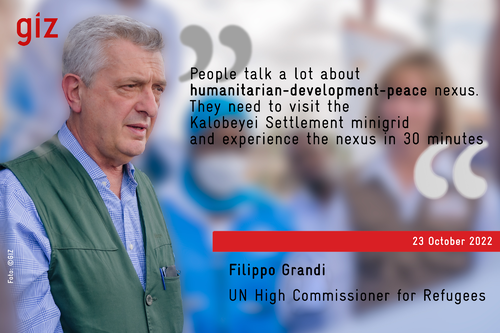Knowledge fuels change
For over a decade, Energypedia has shared free, reliable energy expertise with the world.
We’re now facing a serious funding gap.
Help keep this platform alive — your donation, big or small, truly matters!
Thank you for your support
Difference between revisions of "ESDS Electrification (Mini-Grids)"
***** (***** | *****) |
***** (***** | *****) (updated reugee number and added corresponding factsheet) |
||
| (25 intermediate revisions by 2 users not shown) | |||
| Line 2: | Line 2: | ||
{{ESDS:Link to Portal}} | {{ESDS:Link to Portal}} | ||
| − | = | + | = SUN-ESDS Contributes to High Tier Electricity Supply in Kenya’s Displacement Settings = |
| − | [[file:icon-mini-grid.svg|80px|link=|]] | + | [[file:icon-mini-grid.svg|80px|link=|]][[File:Kalobeyei Minigrid Factsheet English.pdf|thumb|504x504px|Reliable Energy Supply in Displacement Settings. A new solar mini-grid in Kenya creates new opportunities]]'''The SUN-ESDS''' focuses on market-based energy solutions by providing global advisory services, implementing technical and financial measures and cooperating with relevant stakeholders in order to provide [[Access to energy for livelihoods in displacement settings]]. In Kenya, the project seeks to promote access to sustainable energy supply for refugees and their host communities in Turkana West Sub-county. The SUN-ESDS provided both technical and financial assistance for the construction of more than '''40 km of low and medium voltage power distribution lines''' in Kenya's Kalobeyei Integrated Settlement which hosts approximately '''48,000 refugees'''. Additionally, the project provided technical assistance to enable the existing solar mini-grid operator – Renewvia Energy Kenya Limited, attract financing from IFC through the Kakuma Kalobeyei Challenge Fund programme towards expansion of its '''solar mini-grid system from 60kWp to 541kWp with a 1.1 MWh of lithium-ion battery storage capacity''' and '''150 KVA backup generator'''. As a result, '''2,221 new connections (1,929 households, 275 businesses, and 17 social institutions)''' are now served by the expanded mini-grid. These new connections translate to a catchment area of approximately '''10,000 beneficiaries.''' |
| − | + | On 23 October 2022, '''UN High Commissioner for Refugees, Mr. Filippo Grandi''', visited the newly expanded 541kWp Kalobeyei Settlement solar mini-grid. The mini-grid, which is owned and operated by a private-sector company Renewvia Energy, serves as a classic example of how the humanitarian-development-peace nexus can be operationalized to provide sustainable solutions to both refugees and host communities. Mr. Grandi emphasised: [[File:Mr Filippo Grandi visit in Kalobeyei mini-grid.png|alt=Mr Filippo Grandi testimonial|center|thumb|UN High Commissioner for Refugees visits Kalobeyei settlement mini-grid in Kenya|500x500px]] | |
| − | |||
| − | On 23 October 2022, '''UN High Commissioner, Mr. Filippo Grandi''', visited the newly expanded 541kWp Kalobeyei Settlement solar mini-grid. The mini-grid, which is owned and operated by a private-sector company Renewvia Energy, serves as a classic example of how the humanitarian-development-peace nexus can be operationalized to provide sustainable solutions to both refugees and host communities. Grandi emphasised: [[File:Mr Filippo Grandi visit in Kalobeyei mini-grid.png|alt=Mr Filippo Grandi testimonial|center|thumb| | ||
'''SUN-ESDS Contributes to High Tier Electricity Supply in Kalobeyei:''' | '''SUN-ESDS Contributes to High Tier Electricity Supply in Kalobeyei:''' | ||
| − | < | + | <center>{{#widget:YouTube|id=hkD_xKL40RM|height=333|width=500}}</center> |
| − | + | === Electricity supply as a COVID-19 Response Measure: === | |
| + | Prior to the mini-grid expansion, the SUN- ESDS project had provided technical and financial support in 2020 towards electrification of 10 institutions (3 health facilities, 4 schools, 2 accommodation facilities, 1 WFP greenhouse) that were earmarked to offer health and isolation services in Kalobeyei settlement and host town. [[Expanding mini-grids during Covid-19 – Experiences from Kalobeyei]] | ||
| − | + | === Technical Assistance to private mini-grid developers: === | |
| + | As part of its technical assistance to private sector players who have expressed interest to build and operate mini-grids in displacement settings, SUN-ESDS Kenya conducted feasibility studies on mini-grids development in Kakuma 3 and Kalobeyei village 3. | ||
| − | + | === Beyond mini-grids, promoting productive use of electricity: === | |
| + | Increased energy access through mini-grid presents the opportunity to enhance the self-reliance of refugees, ease pressure on the host communities and promote peaceful co-existence. In particular, it spurs economic activity, improved livelihood and income generation; so-called [[Promoting Productive Use of Electricity in Displacement settings]] . This report presents the state of PUE in Kalobeyei, the design and campaign activities and, lastly, identifies the recommendations for replication in displacement settings. | ||
---- | ---- | ||
*[[Access to energy for livelihoods in displacement settings|Access to energy for livelihoods in displacement settings]] | *[[Access to energy for livelihoods in displacement settings|Access to energy for livelihoods in displacement settings]] | ||
Latest revision as of 11:25, 11 April 2024
SUN-ESDS Contributes to High Tier Electricity Supply in Kenya’s Displacement Settings
SUN-ESDS Contributes to High Tier Electricity Supply in Kalobeyei:
Electricity supply as a COVID-19 Response Measure:
Prior to the mini-grid expansion, the SUN- ESDS project had provided technical and financial support in 2020 towards electrification of 10 institutions (3 health facilities, 4 schools, 2 accommodation facilities, 1 WFP greenhouse) that were earmarked to offer health and isolation services in Kalobeyei settlement and host town. Expanding mini-grids during Covid-19 – Experiences from Kalobeyei
Technical Assistance to private mini-grid developers:
As part of its technical assistance to private sector players who have expressed interest to build and operate mini-grids in displacement settings, SUN-ESDS Kenya conducted feasibility studies on mini-grids development in Kakuma 3 and Kalobeyei village 3.
Beyond mini-grids, promoting productive use of electricity:
Increased energy access through mini-grid presents the opportunity to enhance the self-reliance of refugees, ease pressure on the host communities and promote peaceful co-existence. In particular, it spurs economic activity, improved livelihood and income generation; so-called Promoting Productive Use of Electricity in Displacement settings . This report presents the state of PUE in Kalobeyei, the design and campaign activities and, lastly, identifies the recommendations for replication in displacement settings.





















